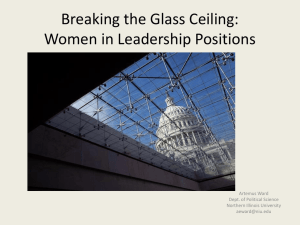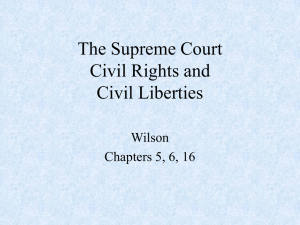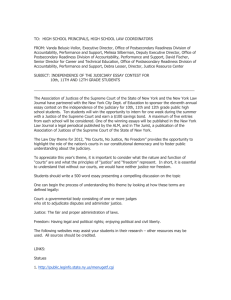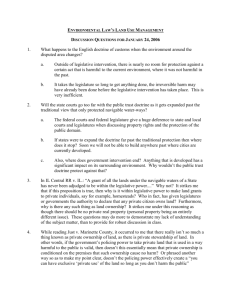Women in the Judiciary - Politics and Government| Illinois State
advertisement
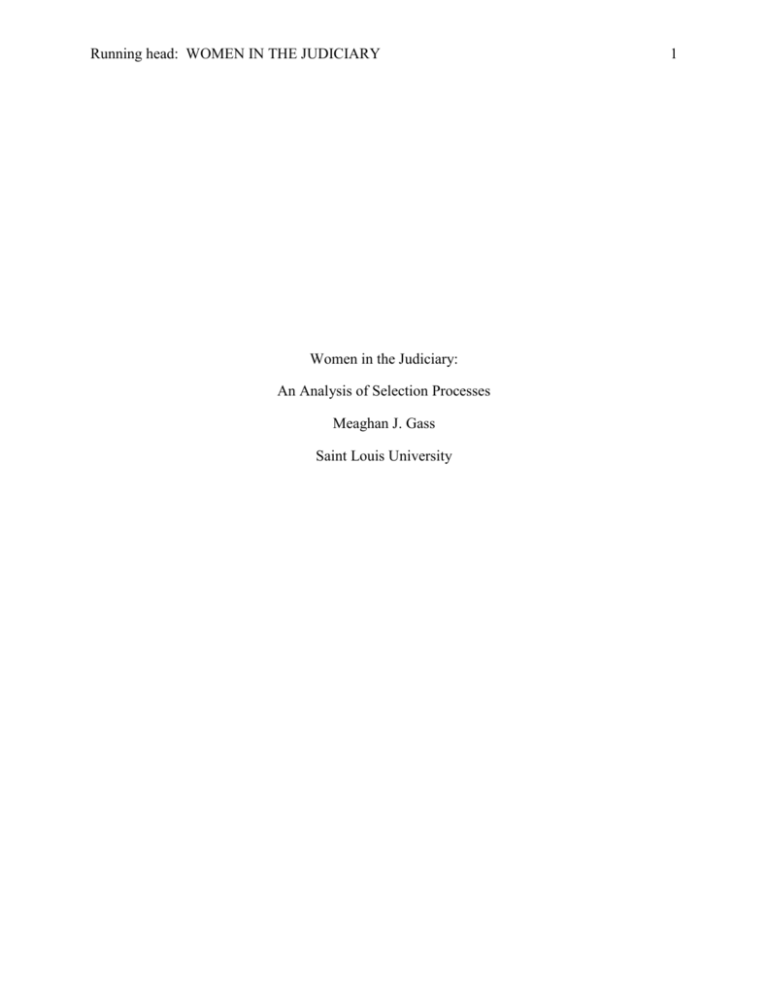
Running head: WOMEN IN THE JUDICIARY Women in the Judiciary: An Analysis of Selection Processes Meaghan J. Gass Saint Louis University 1 WOMEN IN THE JUDCIARY 2 WOMEN IN THE JUDICIARY Introduction As seen in various social movements, increased political participation from historically disenfranchised groups is key to improving social status, namely in the equal protection of rights and interests and the protection from the tyranny of the majority. Yet, nearly ninety-three years following the passage of women’s suffrage, women still have not acquired equal political participation in public office. When looking at one of the most obvious forms of power, elected office, women are not equally present. However, it is not clear what accounts for the difference in proportion of men and women in public office. Thus, researchers strive to account for this gender gap in political representation (Swers, 2002; Fox and Lawless, 2004; Williams, 2008). In these questions underlies the notion that male-dominated institutions are not gender-neutral but promote gender norms that create barrier in women’s entrance in the political arena. Furthermore, this gender gap increases or decreases depending on the political institution. For instance in State Legislatures, about 24 percent of legislators are female, but at the federal level, only 18 percent of females are present in Congress (Center for American Women and Politics, 2013). As is common with most professions, as positions increase in prestige, there are fewer women present. These numbers point to the influence of institutional differences in women in office. In comparison, about 33 percent of the current U.S. Supreme Court (USSC) Justices are women, and women compose roughly 35 percent of State Supreme Courts (CAWP, 2013). It appears, then, on the surface that there is more gender equality in the judiciary than in legislative bodies. What accounts for these differences between institutions? What are the institutional norms that promote or limit gender equality? Why do State Supreme Courts have more even representation of women? In this paper, I analyze the impact of selection processes on gender equality at the state judiciary. I will also evaluate the relationship between eligibility pools and the presence of women on both the state and federal courts. Overall, I hope to explain how institutional factors, like judge selection processes, affect the presence of women in the judiciary. Moreover, this paper replicates a study by Kenney and Windett (2013) which uses similar data and methods. However, my study focuses more on the effects of institutional design, via the selection processes, as opposed to the impact of political culture and diffusion of innovation from other states. Theoretical Argument To begin, I will examine the different selection processes while also accounting for other potential variables that are likely to affect the distribution of women on the courts. There are a variety of mechanisms used to select candidates for judgeships. Election and appointment are the most frequently used methods, but a hybrid of these two selection processes is also common (The Fund for Modern Courts, 2012). To begin, judges may be selected by different elective styles- including partisan, nonpartisan, legislative, and judicial elections. In both the partisan and nonpartisan elections, the public votes to determine the future judge – the main difference is the presence [or absence] of political parties. Currently, eight states use partisan elections to select new judges at the State Supreme Court (SSC) level, while fifteen use nonpartisan elections (American Judicature Society, 2013). In legislative elections, the judges are elected by a vote of the legislature, but this method is only used by two states, South Carolina and Virginia, at the Supreme Court level. At other levels of the state judiciary system, judicial elections are used where the judge selection is based on a consensus of judges (Tokarz, 1986). In this analysis, however, there are not any judges selected using this judicial selection method, but I mention its use in order to clarify the processes of judge selection. WOMEN IN THE JUDCIARY 3 Additionally, judges may be selected via appointment. These appointments can be made by the chief executive [either the Governor or President depending on the level of government]. An “executive appointment” system allows the chief executive to be assisted by a bar association, commission, or an executive council, and then, the candidate is normally approved by the legislative branch [however, this approval process varies among states (Tokarz, 1986). Furthermore, Goldstein (2007) argues that this method best guarantees the independent judiciary since there is no potential retribution from the public over an unpopular decision. A third mechanism of judge selection is the merit-based system, also known as the “Missouri Plan,” which combines the previously explained processes: appointment and election. This method involves many actors including: the governor, the bar, and the bench (American Judicature System). Thirteen states [along with Washington D.C. and Puerto Rico] use this method [or a variation of it] to select judges (American Judicature System). In this selection process, three candidates are first nominated by a commission with composition varying from state to state. Then, a candidate is appointed by the chief executive (i.e. the governor). Finally, after a full year of service, the judge is fully confirmed by a nonpartisan, retention election. If the judge does not receive a majority of the votes, then the entire process restarts at the nomination phase (Tokarz, 1986). The use of different judiciary styles has been debated since the founding of the United States, subsequently resulting in the different selection processes. Famously, Alexander Hamilton pushed for an independent judiciary, while Thomas Jefferson wanted a judiciary whose decisions would be held accountable by the public. In order to achieve an independent judiciary, many believe that the appointment system is the best, but elections can be used in order to have judges accountable to the public [because if they are not, then they would be removed from office with electoral change]. Furthermore, the merit-based system developed in order to remove some of the politics in the judge selection process. By having a commission select potential candidates first, then there will be reduced bias and preferential treatment of the chief executive (Goldstein, 2007). The continued use of these different mechanisms for judge selection demonstrates that the debate between Hamilton and Jefferson is ongoing. In regards to enhancing gender equality in judgeships, the assumption is that the process resulting in the greatest number of women judges present within the court is the better selection process. As scholars note, however, it would be foolhardy to assume that any selection or electoral process is gender-neutral simply because the end result is roughly equal representation between men and women (Fox and Lawless, 2004). Rather, gender socialization occurs within most [if not all] processes and is unlikely to be neutral. In this paper, I hope to further explore the selection processes of judges in order to better understand which tactics promote greater gender equality. In the election process, the initial decision to run for office is a crucial step in eventually holding office. When considering the factors in the decision to run calculus, political ambition— the desire to hold office—plays an initial key role. Extant literature focuses on the gender gap related to state and federal legislators as opposed to judgeships. As a result, there is little known about gender differences in political ambition and the judiciary- a gap my study hopes to fill. Within the existing literature related to legislative branches, Fox and Lawless (2004) examine the interaction between gender and the initial decision to run for legislative office by looking at four general areas in which traditional gender roles are likely to impact the propensity to run. These areas are political culture, family responsibilities, self-perceived qualifications, and ideological motivations. Fox and Lawless (2004) find potential female candidates’ self-perceived WOMEN IN THE JUDCIARY 4 qualifications to be the strongest determinant in the decision not to run. In other words, women are significantly less likely than men to perceive themselves as being qualified to run. Moreover, this phenomenon holds true even for women at the highest professional positions. Fox and Lawless (2004) also find that women are far less likely to be encouraged to run for office. In other words, women self-perceive as unqualified, and then, recruitment processes solidify those perceptions. Gender socialization processes are likely to have an impact on the differences between men and women’s initial decision to run for public office and pursuing this decision in an actual campaign. While this finding is conclusive in regards to the state legislature, I expect similar findings in my analysis on the judiciary. In addition to these self-perceptions, the political culture also plays a role in the decisionmaking process in running for elected office. Hill (1981) finds that there is a greater likelihood for women to run for legislative office when the political culture of the state has a greater level of gender egalitarian norms – for instance early acceptance of women’s suffrage, lower levels of female discrimination, and more equal levels of educations. Conversely, he finds that women run less when the political culture follows more traditional gender norms. In addition to political culture, there may be incentives for women to pursue judgeships via election or accept them via the other processes. For instance, Williams (2008) finds that women are more likely to advance in the judiciary as opposed to the legal profession. For instance, women compose only 15 percent of partners in law firms (CNN, 2013). In U.S. District Court and Courts of Appeal, 30 percent of the fulltime judges are women (United States Courts, 2013). Similarly, roughly 35 percent of SSC judges are women (Rutgers, 2013). Thus, judgeships may present fewer institutional barriers in acquiring prestigious positions. The effect of ambition on the decision to run is also affected by perceptions of the surrounding environment such as prospects of winning. As studies find differences between men and women’s political ambition, it may also be likely that gender has an impact in the responsiveness to political opportunities in the decision to run calculus (Bledsoe and Herring, 1990; Fox and Lawless, 2004). For example, Bledsoe and Herring (1990) find significant differences between men and women’s likelihood to run as well as the overall proclivity of men to respond to ambition in choosing to run for elected office. Similarly, Fulton et al. (2006) find that, “ambition elicits different reactions from men and women depending upon the structure of political opportunities, like the prospects of winning” (p. 236). They find that both men and women are responsive to the intersection of ambition and opportunity, but women’s decisions to run calculus are more responsive to these perceptions than men (Fulton et al., 2006). Thus, for women, the likelihood to run is positively impacted by the combination of ambition and opportunity – meaning women tend to be more strategic when deciding to run for office (Fulton et al., 2006). In comparison to running for state judgeships, appointed positions follow a different process. Judith Kaye, the former chief judge of the New York Court of Appeals, reflects on the process of being appointed to the courts, “In the early 1980s, suddenly people were looking for women, […] Since I was one of the few female commercial practitioners around with so much21 years-experience, I was sought out for both the federal trial court and the state’s highest appellate court.” (Filisko, 2012, p.11). Concurrently [in 1981], Sandra O’Connor was appointed to the USSC, which may account for this rise in female judgeships. Also, it is important to note that Kaye was selected for the judgeship after submitting an application to be appointed as a judge. Thus, even in the appointment process, ambition sometimes plays a role. WOMEN IN THE JUDCIARY 5 In all judge selection methods, the eligibility pool plays a role since this pool provides the prospective candidates eligible for judgeships. In general, in order to be qualified to be a judge, it is important to be both professional and qualified (Filisko, 2012). Also, one must be from the legal profession. However, this assumption does not hold true for all states. For instance, in Massachusetts and New Hampshire, the only requirement to become a Supreme Court judge is a “mandatory retirement age of 70,” but in the other states, there is a legal background needed to become a judge (American Judicature Society, 2013). Furthermore, careers that serve as pipelines to the eligibility pool vary from state to state and court to court. For instance in the New York Court of Appeals, the traditional route is judicial experience on lower courts, but judges are still selected without this background of experience (Filisko, 2012). At the federal level, there are no specific requirements listed in the Constitution, but at the same time, “informal criteria” are used. The informal criteria are dependent on recommendations by Congress and the Department of Justice who also play a role in evaluating prospective candidates (United States Courts, 2013). However, given the higher prestige of the federal courts, it is assumed that a legal background in addition to the professional experience would be a prerequisite. Furthermore, Williams (2008) finds that women may be more likely to pursue careers in the judiciary than other forms of office due to its more clearly defined qualifications [in comparison to the qualifications of other offices]. In legislative office, scholars have noted that women sometimes doubt their qualifications and therefore choose not to run for office (Carroll, 1994). Thus, having clear criteria may allow more women to express their desire for judicial office. As previously outlined, the criteria generally consist of professional background in law. Thus, an unambiguous pipeline may give the judicial branch an advantage in achieved equal presence of men and women when compared to the other branches of the government. Additionally, the chief executive also impacts judgeship appointments. At the federal level, Tobias (1991) finds that, “every President in recent history has increased the numbers and percentages of women appointed to the federal judiciary over time, mainly at the end of his first term or during his second term, if re-elected” (p. 481). Thus, at the federal level, women have a greater opportunity to be selected as a judge depending on the term cycle. Also, individual chief executives appoint more women to judgeships than others. For instance at the federal level, the rate of female appointments varied from about 16 percent with Carter to roughly 8 percent with Reagan (Tobias, 1992-93). Clearly, the opportunity of appointment is dependent upon who is in office. Overall, there is a wide variety of factors that impact the presence of women in the judiciary. In the next section, I explain the research methods used in the analysis. Research Methods For my research paper, I analyze the role of institutional structure in relation to gender equality in both State and Federal Supreme Court systems. I expect both the merit-based and appointment process to result in higher predicted levels of women on State Supreme Courts than the election processes. Considering that these two processes are the least similar to the election processes used for the legislative and executive branches, which both have a lower percentage of women present in comparison to the judiciary, I anticipate that using a different selection process will lead to a greater presence of women. Moreover, for a clear list of variables used in this model, reference Table 1, and for summary statistics of these variables, reference Table 2. Furthermore, since my data is both time series and cross sectional, I use a time series ordinary least squares regression for the bulk of the analysis. I focus on the overall presence of female justices on these benches. For the scope of this paper, I use presence of females on the WOMEN IN THE JUDCIARY 6 State and Federal Courts as a proxy for gender equality. By measuring gender equality by the amount of women present, I do not mean to imply that the mere presence of women in political bodies equates to more gender equality considering that women may not promote a pro-woman agenda or may be limited in action due to institutional structures that constrain women’s power and influence within the institution. However, having more representation of women in political bodies is an indicator of more avenues toward gender equality in the political arena. First, I examine the impact of the eligibility pool on the level of female judges at the SSC level and the federal judiciary level. Essentially, I analyze the relationship between the percent of female attorneys and the percent of female judges to see if the predicted relationship of a larger eligibility pool increasing the presence of women on the courts holds true. It is important to note that at the federal level, the process of judge selection is similar: appointment by the President and confirmed by Congress (United States Court, 2013). However, there is variation between the distribution of women on the different courts at the federal level. Next, I compare the institutional design, meaning the justice selection process, of State Supreme Courts in order to see which selection process promotes the most equality and inclusion of females in the court system. I focus on the SSC due to the variance of institutional structures from state to state. Thus, this selection allows for more interesting findings because one can compare the differences between institutional structures and their relationship to equal gender representation, while also understanding state trends in the judiciary. At the SSC level, there are seven different judge selection mechanisms: Partisan Election, Nonpartisan Election, Merit-Based System, Legislative Election, Gubernatorial Appointment with Legislative Confirmation, Gubernatorial Nomination with Executive Council Approval, Gubernatorial Appointment with Confirmation on Judicial Appointment by the State Bar of CA. Reference Figure 1 to establish which process each state uses.1 1 I included Maryland in my analysis even though its highest court is the Court of Appeals since its functions are similar to other courts (Maryland Courts, 2013). WOMEN IN THE JUDCIARY 7 Figure 1: State Supreme Court Judicial Selection Processes While there are technically seven different processes of judge selection in the State Supreme Courts, I combine the last three mechanisms in my model (Gubernatorial Appointment with Legislative Confirmation, Gubernatorial Nomination with Executive Council Approval, Gubernatorial Appointment with Confirmation on Judicial Appointment by the State Bar of CA). I consolidate the measurement of appointment to the judiciary in order to create comprehension in the results. Furthermore, in my analysis, I use two different models. In the first model, I include legislative election, which is used in South Carolina and Virginia, and in the second model, I exclude it since the sample of legislative election was so small it could potentially skew the data. Moreover, since institutional structure is not the single-factor influencing gender [in]equality, I control for other possible determinants in the model to evaluate to their impact. These controls include: gender equality indicators, citizen ideology score, neighbor diffusion, regional differences, when O’Connor is nominated to the USSC, presence of a female chief justice, and presence of a female governor. WOMEN IN THE JUDCIARY 8 Table 1: Variables Used in State Supreme Court Analysis Response Variable Percent of Female Judges Explanatory Variables Judge Selection Processes Partisan Election Nonpartisan Election Legislative Election Merit-Based System Appointment Female Chief Justice Dummy Number of Contiguous States Sitting Female Governor Dummy O’Connor Dummy Gender Equality Score State Citizen Ideology South Dummy Definition Female SSC / total justiceships Main Source Kenney and Windett, 2012 Definition Main Source American Judicature Society Statewide popular elections with partisan affiliations Statewide population elections without partisanship Election by Legislature Nominating Commission selects 3 candidate pool from which the Governor appoints Governor appoints candidate who is approved by Senate Governor appoints candidate who is approved by Executive Council Governor appoints candidate who is approved by CA State Bar Dummy to account for a women serving as chief justice The number of states bordering a state Dummy to account for the presence of Female Governor Dummy to account for the appointment of Sandra Day O’Connor to the USSC in 1981 Factor score with 9 indicators of gender equality and institutions over time A measure of the ideology of state citizenry Dummy to account the Southern portion of the United States Kenney and Windett, 2013 Kenney and Windett, 2013 Kenney and Windett, 2013 Kenney and Windett, 2013 Windett, 2011 Berry et al., 1998 Kenney and Windett, 2013 Table 2: Summary Statistics Response Variable Percent of Female Judges Observations 2100 Mean 15.26 Standard Deviation 16.04 Minimum 0 Median 14.29 Maximum 60 Explanatory Variables Judge Selection Processes Female Chief Justice Dummy Number of Contiguous States Sitting Female Governor Dummy O’Connor Dummy Gender Equality Score State Citizen Ideology South Dummy Observations 2100 2100 2100 2100 2100 2058 1950 2100 Mean 2.64 Standard Deviation 1.03 Minimum 1 Median 3 Maximum 4 2..74 2.00 0 3 8 -0.15 47.498 1.06 16.033 -2.8 7.042 -0.21 58.59 2.43 95.177 WOMEN IN THE JUDCIARY 9 As previously noted, I account for regional differences between State Supreme Courts. For instance, the South has the culture of Southern womanhood which is unique to this region and idealizes traditional gender roles. In comparison, western states used women’s suffrage as a means to statehood which in turn promoted gender equality in the state’s foundation. Thus, states have varied histories of promoting gender equality. In order to account for potential differences between regions, I include a regional dummy variable to control for southern states. I will also include variables to account for gender equality and citizenry ideology in a state. These variables will provide good estimates of each state’s political culture. I include the variable accounting for O’Connor’s nomination to the USSC since she was the first women nominated to the United States’ highest court. As a result, it may increase the likelihood of choosing women for the State Supreme Courts. I also include the variable in regards to whether or not a state has a female governor for two reasons. First, in the appointment mechanism, the governor generally appoints the prospective candidates, and if the governor is female, she may nominate more female candidates. Also, if a state elects a female governor, they may be less opposed to electing a female state justice [in states where partisan and nonpartisan elections are used]. In addition, I take into account the presence of a female chief justice on the State Supreme Court since her presence may in some way increase the likelihood of selecting female judges. Overall, this model and its variables can capture the majority of the variance between institutional design of State Supreme Courts and gender equality in judgeships. To recapitulate, I expect appointment and the merit-based system to lead to a greater presence of women on the State Supreme Courts since these two methods are the most distinguished methods from the election processes used in the executive and legislative branches which both have histories of lower levels of women present in elected office. Analysis To begin, I will analyze the role of the eligibility pool on the presence of female judges at both the State and Supreme Court levels. Then, I will examine the impact of specific judicial selection processes, along with other control variables, on the presence of women on State Supreme Courts. For results in regards to the eligibility pool, see Figure 2 and 3 below. Eligibility pools are important to include in the analysis since candidates selected for positions are chosen from these potential judgeships, and as a result, an increase of women in the eligibility pool could lead to an increase in the presence of women on the courts. For this analysis, I use the percent of female attorneys as a proxy for the eligibility pool since having a background in law is a general requirement at both the federal and SSC levels.2 2 As previously noted in the paper, Massachusetts and New Hampshire are exceptions to this requirement since they only have an age limit in regards to their restriction of the eligibility pool. WOMEN IN THE JUDCIARY 10 0 10 20 30 Figure 2: The Relationship between Percent of Female Lawyers and the Percent of Female Federal Judges 0 10 20 30 Percent of Female Federal Judges Fitted values 40 Percent of Female Attorneys 0 10 20 30 Figure 3: The Relationship between the Percent of Female Lawyers and the Percent of Female SSC Justices 0 10 20 30 40 Percent of Women on State Supreme Courts Fitted values Percent of Female Attorneys From Figure 2 and 3, the female eligibility pool for judgeships increases as more women become lawyers, and as a result, there is a subsequent increase in the level of females present on both WOMEN IN THE JUDCIARY 11 Federal Courts and the State Supreme Courts. While these figures do not account for the pipelines to the judgeships, they display a positive relationship between the percent of female judges and the percent of female attorneys. In order to better understand the distribution of the judicial selection processes over time, reference Figure 4 and 5. In Figure 4, I included legislative elections, and in Figure 5, I excluded them due to this mechanism only being used by two states, South Carolina and Virginia. In both of these figures, the mean of the percent of females judges is graphed by judicial selection processes from 1970-2010. 0 10 20 30 40 Figure 4: The Mean of the Percent of Female Judges by Judicial Selection Processes, 1970-2010 1970 1980 1990 1992 Partisan Election Merit-Based Selection Appointment 2000 2010 Nonpartisan Election Legislative Election In Figure 4, legislative elections are included, but their inclusion is not very informative since changes in the composition of the courts are more visible due to the small sample size. Thus, including legislative election only illustrates the trends of two states as opposed to a broader picture of the impact of this judicial selection process. WOMEN IN THE JUDCIARY 12 0 10 20 30 40 Figure 5: The Mean of the Percent of Female Judges by Judicial Selection Processes, 1970-2010 1970 1980 Partisan Election Merit-based system 1990 1992 2000 2010 Nonpartisan Election Appointment Note: This graph does not include information South Carolina and Virginia due to their use of legislative elections. As a result, I also included Figure 7 which presents a more accurate illustration of trends of judicial selection processes in State Supreme Courts. In this figure, the shift in the slope in the early 1990s is particularly interesting.3 Prior to this period, the increase in the mean of the percent of female judges is more subtle, but in 1992, the mean percent of female judges rises at a much faster rate. 1992 is also known as the “Year of the Woman” where the presence of elected women spiked (Swers, 2002). While there is an increase in female legislators, there is a simultaneous increase in female judges at the SSC level. Interestingly, the presence of women in different political bodies increased concurrently which demonstrates the likelihood of coexisting factors to increase the presence of women regardless of the political institution. Next, I discuss the impact of judicial selection processes on the presence of women on State Supreme Courts. For my regression table, please reference Table A1 and A2 in the Appendix. Figure 6 and 7 demonstrate the relationship between the selection processes and the predicted percent of Female SSC judges, and to clarify, Figure 6 includes Virginia and South Carolina in the analysis while Figure 7 excludes them due to the small sample of data. 3 This shift is not as clearly seen in the merit-based system where the rise appears to be relatively constant over time. WOMEN IN THE JUDCIARY 13 en t Ap po in tm e la tiv Le gi s er itB M El Sy as ed El sa n rti N on Pa ec tio n io n ec t tio n El ec sa n Pa rti st em 10 20 30 40 Figure 6: The Predicted Percent of Females on State Supreme Courts by Selection Mechanism (90% CIs) In Figure 6, legislative election provides the largest predicted percent of females on State Supreme Courts, followed by partisan election, nonpartisan election, appointment, and meritbased system. Interestingly, legislative election has the highest predicted percentage of female judges in comparison to all of the other processes, except for partisan election due to overlapped confidence intervals. Also, all forms of election (partisan, nonpartisan, and legislative) are more likely to have a higher predicted percent of female judges when compared to the merit-based system and the appointment process. While these results demonstrate the impact of judicial selection processes in the United States, they may be skewed in favor of legislative elections due to their limited use across America, and as result, I used a similar model where I eliminated this selection process. WOMEN IN THE JUDCIARY 14 Sy er itBa se d en t M Ap po in tm st em io n El ec t N on pa rti sa n Pa rti sa n El ec tio n 5 10 15 20 25 Figure 7: The Predicted Percent of Females on State Supreme Courts by Selection Mechanism (90% CIs) Note: This graph does not include information South Carolina and Virginia due to their use of legislative elections. From Figure 7, partisan election provides the largest predicted percent of females on the State Supreme Courts, followed by nonpartisan election, appointment, and merit-based system. However, similarly to the previous model, only the relationship between partisan elections and nonpartisan elections are significant when compared to the merit-based system and the appointment method since their confidence intervals do not overlap with these selection processes. Thus, both forms of election provide higher levels of women on State Supreme Courts than the merit-based system and appointment process. Furthermore, when one compares the r-squared values between the two models in this study, it increases from 0.396 to 0.465 when legislative election is removed from the analysis. Thus, while both models predict a large portion of the variance related to the presence of women on State Supreme Courts, the latter model, excluding legislative election, is a better predictor. In addition to judicial selection processes, other variables included in the model have a statistically significant impact on the predicted presence of women on State Supreme Courts. In fact, both the gender equality score and being a southern state account for greater variance of the response variable. To be exact, they both positively impact the percent of female SSC judges to a greater extent than the judicial selection processes. It is intuitive that a state with a higher gender equality score tends to have fewer traditional gender norms which then would increase the amount of female professionals, such as the judiciary. In comparison, being a southern state seemed counter-intuitive at first due to ‘Southern Womanhood’ and more traditionalistic gender roles prominent in the south. However, at the same time, southern states have a tradition of a high percentage of female SSC judges. Furthermore, as noted in Figure 6, legislative election had the highest predicted percent of female WOMEN IN THE JUDCIARY 15 judges when compared to the other processes [with the exception of partisan election]; the only states that use this process are South Carolina and Virginia which are also southern states. Thus, this regional relationship could also account for part of the higher levels of female SSC judges in South Carolina and Virginia. Moreover, other significant variables of both models are the presence of a female chief justice on the SSC, the number of contiguous states, the year O’Connor was appointed to the USSC, and state citizen ideology. They all have a positive relationship on the predicted levels of women on State Supreme Courts. In conclusion, the results of both my models proved my original expectations, where the merit-based system and appointment process result in a greater presence of women on State Supreme Courts, to be incorrect. Instead, the election processes result in a higher likelihood of more women on State Supreme Courts. This finding is interesting due to its similarity to state legislators. Specifically, when running for office, women win at equal rates as men, pointing to the common phrase of, “when women run, women win.” Therefore, the overall election process may be more beneficial to women’s entrance into political bodies than other selection processes. Conclusion Overall, judicial selection processes have an impact on the presence of women on State Supreme Courts. From this analysis, election processes promote a greater presence of women in the state judiciary in comparison to appointments and the merit-based system. However, other indicators, like the gender equality score and being a southern state, have a greater impact on the presence of women on these courts. Furthermore, I believe the proportion of women in the eligibility pool would also have a significant impact, but I was unable to include this variable in my analysis due to limitations in data collection. To expand this analysis in the future, I will incorporate the presence of women on Federal Courts. However, since Federal Courts tend to use appointment as the selection process, the study would vary from this analysis, but I would like to see if having a Democrat or Republican president would lead to more or less female appointments at the federal level. In further research, it will be interesting to see if the recent 2012 election will have any impact on the presence of females on State Supreme Courts. In the 2012 election, more women were elected to the U.S. Congress than in 1992, “Year of the Woman,” when elected female legislators spiked (Hook, 2012). As noted in the analysis, there was a simultaneous shift in both female legislators and state justices in 1992 when women were selected for public office at a higher rate. Perhaps, this shift in female justices will continue to occur with more equal representation of women in elected office as it did in 1992. To further improve this analysis, I would employ a regression discontinuity design which would allow me to have more nuanced results in relation to the shift in slope before and after 1992. Moreover, considering that laws are precedent-based, are difficult to change, and have their origins in male-dominated legislatures, it is important to determine the key variables that promote greater gender equality in the judiciary as a means of promoting enhanced female representation in law. This study is a step forward in determining those factors in hopes of achieving greater gender equality. WOMEN IN THE JUDCIARY 16 Appendix Table A1: Regression Output- Predicting the Impact of Judicial Selections Processes on the Presence of Female State Supreme Court Justices Judicial Selection Processes Nonpartisan Election Merit-Based System Legislative Election Appointment Control Variables Female Chief Justice Dummy Number of Contiguous States Sitting Female Governor Dummy O’Connor Dummy Gender Equality Score State Citizen Ideology South Dummy Constant N R-Squared Overall -2.923 (3.129) -10.512*** (3.249) 10.511* 5.805 -9.903** (3.458) 5.317*** (0.791) 1.948*** (0.252) 1.773* (1.027) -1.599* (0.884) 12.186*** (0.628) 0.140*** (0.032) 7.882*** (2.573) 9.271*** (3.384) 1568 0.396 *p<.10; **p<.05; ***p<.01 Note: Coefficients are reported. Standard errors are included in parentheses below the coefficient. WOMEN IN THE JUDCIARY 17 Table A2: Regression Output- Predicting the Impact of Judicial Selections Processes on the Presence of Female State Supreme Court Justices Judicial Selection Processes Nonpartisan Election Merit-Based System Appointment Control Variables Female Chief Justice Dummy Number of Contiguous States Sitting Female Governor Dummy O’Connor Dummy Gender Equality Score State Citizen Ideology South Dummy Constant N R-Squared Overall -2.994 (2.369) -9.559*** (2.463) -7.961*** (2.606) 7.278*** (0.760) 1.513*** (0.205) 1.165 (0.941) -1.117 (0.740) 10.383*** (0.466) 0.065** (0.026) 7.111*** (1.963) 12.136*** (2.566) 1833 0.465 *p<.10; **p<.05; ***p<.01 Note: Coefficients are reported. Standard errors are included in parentheses below the coefficient. This regression output does not include information about South Carolina and Virginia due to their use of Legislative Elections. WOMEN IN THE JUDCIARY 18 Bibliography American Judicature Society (2013). Methods of Judicial Selection. Retrieved from http://www.judicialselection.com/judicial_selection/methods/selection_of_judges.cfm Berry, W. D., Rinquist, E. J., Fording, R. C., & Hanson, R. L. (1998). Measuring Citizen and Government Ideology in the American States, 1960-93.” American Journal of Political Science, 41, 327-48. Bledsoe, T. & Herring, M. (1990). Victims of Circumstances: Women in Pursuit of Political Office. American Political Science Review, 66 (1), 144-59. Carroll, S. (1985). Political Elites and Sex Differences in Political Ambition: A Reconsideration. Journal of Politics, 47: 1231-43. CNN (July 25, 2013). Why Women Don’t Make Partner. Accessed from http://www.cnn.com/2013/07/25/business/why-women-dont-make-partner/ Filisko, G. M. (2012). The Pipeline to the State Judiciary. Perspectives, 21 (1), 10-14. Fox, R. & Lawless, J. (2004). Entering the Arena? Gender and the Decision to Run for Office. American Journal of Political Science, 48 (2), 264-280. Fulton, S. A., Maestas, C. D., Maisel, L. S., & Stone, W. J. (2006). The Sense of a Woman: Gender, Ambition, and the Decision to Run for Office. Political Research Quarterly, 59, 235-248. Kenney, S. J. & Windett, J. (2013). Diffusion of Innovation or State Political Culture? Explaining the First Women State Supreme Court Justices. Working Paper. Retrieved from http://2012sppconference.blogs.rice.edu/files/2012/02/Kenney_Windett_SPPC_ Draft.pdf Goldstein, A. (2007). Judicial Selection as It Related to Gender Equality on the Bench. Cardozo Journal of Law & Gender, 13, 369-405. Hook, J. (2012). Another ‘Year of Women’ in Congress. The Wall Street Journal. Maryland Courts (2013). Court of Appeals- Welcome. Accessed from http://www.courts.state.md.us/coappeals/ Center for American Women and Politics (2013). Current Numbers of Women Officeholders. Retrieved from http://www.cawp.rutgers.edu/fast_facts/levels_of_office/ Current_Numbers.php The Fund for Modern Courts (2012). Methods of Judicial Selection. Accessed from http://www.moderncourts.org/advocacy/judicial_selection/methods.html Tobias, C. (1991). More Women Named Federal Judges. Florida Law Review, 43, 477-86. Tobias, C. (1992-93). Closing the Gender Gap on the Federal Courts. Cincinnati Law Review, 61, 1237-49. Tokarz, K. (1986). Women Judges and Merit Selection Under the Missouri Plan, 64 Wash. U. L. Q. 903. Available at: http://digitalcommons.law.wustl.edu/lawreview/vol64/iss3/10 United States Courts (March 29, 2013). Decades After O’Connor, Role of Women Judges Still Growing. Accessed from http://news.uscourts.gov/decades-after-oconnor-role-womenjudges-still-growing United States Courts (2013). Federal Judges. Accessed from http://www.uscourts.gov/Common/FAQS.aspx Williams, M. (2008) Ambition, Gender, and the Judiciary. Political Research Quarterly, 61 (1), 68-78. WOMEN IN THE JUDCIARY Windett, J. (2011). State Effects and the Emergence and Success of Female Gubernatorial Candidates. State Politics & Policy Quarterly, 11 (4), 460-482. 19

